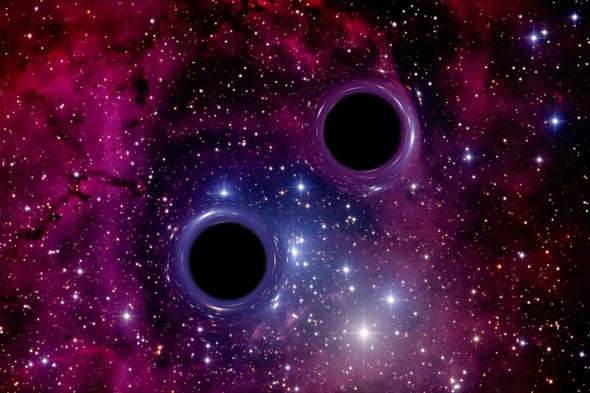by IMRE BARTO, ZSUZA MARKA, & SZABOLCS MARKA

On May 24 the Laser Interferometer Gravitational-Wave Observatory (LIGO) will resume its hunt for gravitational waves—tiny, periodic variations in the curvature of space and time created by distant, violent cosmic events such as two colliding black holes.
Some would call gravitational-wave scientists lucky, based on their field’s remarkable series of transformative discoveries occurring in less than a decade’s time. In each of their first three observing periods, gravitational-wave detectors found or confirmed a new astrophysical phenomenon. First, in 2015, the collision of black holes, followed two years later by the collision of ultracompact, dead stars called neutron stars, and then in 2019, objects with masses that were not expected to exist in the universe.
Past performance is no guarantee for future success. However, as LIGO turns on this month (followed by two other detectors: Virgo in Italy and KAGRA in Japan) there are good reasons to be optimistic about continuing this trend of cosmic discovery.
Considering how productive these detectors are, why do astronomers turn them on and off in the first place? The simple answer is that observing gravitational waves builds on cutting-edge technology that is rapidly advancing. That allows scientists to detect gravitational waves across an order of magnitude larger swath of the universe than they could back when the very first direct detection occurred. However, the upgrade of gravitational-wave detectors is a complex and time-consuming endeavor. It cannot be done in parallel with observations. Hence the observing periods: scientists alternate between improving their detectors and listening to the sky.
Surveying this substantially expanded volume of the cosmos virtually guarantees that observers will find new skeletons in the cosmic closet—discoveries that could transform astrophysics and science at large. Here, we’ve cataloged the six potential breakthroughs that we most eagerly await:
1. The heaviest black holes. The heaviest black hole we have detected so far with gravitational waves weighs about 100 times the mass of our sun. However, thanks to upgrades our detectors are now sensitive to gravitational waves emanating from colliding black holes that are 1,000-fold heavier than our sun. Discovering these much heavier black holes would be a game changer; it would tell us how black holes grow and how some of them reach supermassive sizes of millions or billions of times as massive as our home star. We know of such supermassive black holes in the centers of large galaxies, but their origin is currently a mystery.
2. Radiating black hole collisions. Black holes are special because nothing, not even light, can escape from them. However, suppose two black holes collide amid a cloud of interstellar gas. Such a collision could spark cosmic fireworks in this surrounding material. Detecting the electromagnetic or possibly even neutrino signature of such collisions, along with gravitational waves, would be a major discovery. With such data we could identify with high precision where and how the crash happened, obtaining vibrant new details about previously inaccessible extreme cosmic environments. This precise localization of a gravitational-wave signal could also offer astronomers a new, independent way of measuring just how fast the universe is expanding.
3. The origin of gold and platinum in the universe. While most elements in the universe are forged inside stars through thermonuclear fusion, the heaviest elements, such as gold, platinum or uranium, need a special creation process. In 2017, scientists managed to glimpse both gravitational waves and light simultaneously emitted by a colliding pair of neutron stars, revealing how—and how much—these events produce such heavier elements. Whether neutron star collisions are in fact the primary source of cosmic gold remains unclear, but what’s certain is that finding and studying more of these collisions will settle the intense ongoing debate—and give us a better understanding of where and when the element-constrained conditions for life as we know it can cosmically arise.
Scientific American for more
